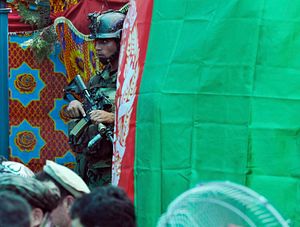After nearly 17 years of fighting and efforts at state building, Afghanistan’s future is as clouded as ever. The conflict has at best reached a stalemate.
Much of our thinking on achieving peace holds that a decisive military victory is unattainable and a negotiated political compromise with the insurgents is therefore inevitable. As envisioned, steady military pressure together with Pakistan’s exercise of influence on the Taliban will induce its reluctant leadership to negotiate. In exchange for greater recognition of their beliefs, the Taliban in a power-sharing agreement are expected to accept the prevailing constitutional framework and the social rights and economic gains achieved since 2001.
Of late, there is a growing sense of optimism about peace prospects, despite a new surge of violence. Hopeful signs include President Ashraf Ghani’s generous offer to the Taliban, overlapping brief Eid ceasefires, and the emergence of a nonviolent grassroots movement pleading for peace. Hopes have risen further with revealed back-channel discussions and a Doha meeting in late July bringing together U.S. officials and Taliban representatives to discuss ways to get formal talks underway.
Yet a comprehensive political agreement with the Taliban and the linked Haqqani Network remains at best a distant prospect. The senior Taliban leadership continues to balk at having the Kabul government as a participant in negotiations and insists on the withdrawal of foreign military forces. A dominant hardcore remains confident that with persistence, a restoration of an Islamic Emirate is achievable. It is a vision of Afghanistan largely incompatible with the pluralistic, democratic system still favored by most Afghans.
The prospect of peacefully resolving the Afghan conflict in a grand bargain hammered out around a table in Doha, Geneva, or anywhere, has never been realistic. It grows out of wishful thinking born of our desperation to find a way out of a seemingly interminable conflict and has kept us from seriously facing up to other possible outcomes. Absent outright military victory over the insurgency or a comprehensive political deal, what might then lie ahead for Afghanistan? Four plausible alternative futures of varying probability and consequence stand out, only one of which is conceivably positive.
A pathway toward a positive future would involve a gradual, incremental peace process led by an Afghan government that is able to create the incentives needed to induce individual insurgent field commanders and their fighters to lay down their arms. This process of reintegration envisions over time their disaffection from core leadership and reintegration into the economic, political, and social fabric of the country.
In a second conceivable future, the conflict continues inconclusively and indefinitely, with neither side achieving a decisive victory. It might leave the combatants fighting over the same landscape, but could also result in government forces only defending the larger population centers and in effect ceding control of much of the countryside to the Taliban and other insurgents. This scenario presumes the continued presence of foreign troops and generous international financing, and that the Kabul government is not brought down from within by clashing political interests and ambitions.
A third scenario envisions the insurgency over time overrunning Afghan security forces and compelling foreign militaries to withdraw their forces and international donors to turn their backs on Afghanistan. This outcome could also occur politically when, from a position of ever-increasing strength, the Taliban agrees to negotiate and is able to dictate peace terms. In this scenario, Afghans, exhausted from decades of conflict, most Afghans, however reluctantly, would accept the restoration of an Islamic Emirate. At the same time, millions of other Afghans will be forced to flee the country, mostly to Pakistan.
A fourth, and darkest scenario, depicts the collapse of the Kabul regime, whether from internal discord or the exit of foreign forces. But instead of the Taliban’s consolidation of power, this scenario sees fractionalization within the insurgency, the fragmentation of the Afghan state into competing ethnic and other militia groups, and regional country proxy intervention – all contributing to a bloody, open-ended, and chaotic civil war.
Only by confronting the full range of possible outcomes and their consequences can we fully appreciate how much is at stake for the Afghan people, the United States, and the international community in the survival of the Kabul government and prevailing constitutional system. To cling to the illusion that a negotiated shortcut to end the conflict exists detracts from the importance and urgency of undertaking the critical reforms necessary for a reintegration process to succeed.
None of this means we should not be open to sincere insurgent peace overtures. But chasing after the Taliban in the hope of starting a peace process is not harmless or cost-free. It conveys to our adversaries not sincerity but desperation, and to our friends, it creates false and ultimately crushed hopes.
Dr. Marvin G. Weinbaum is professor emeritus of political science at the University of Illinois at Urbana-Champaign, and served as analyst for Pakistan and Afghanistan in the U.S. Department of State’s Bureau of Intelligence and Research from 1999 to 2003.
Samad Sadri is is Dr. Weinbaum’s research associate.

































